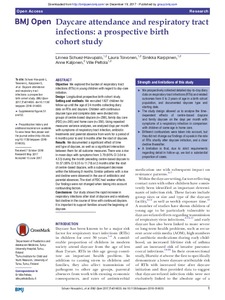Daycare attendance and respiratory tract infections: A prospective birth cohort study
Toivonen L.; Schuez-Havupalo L.; Karppinen S.; Peltola V.; Kaljonen A.
https://urn.fi/URN:NBN:fi-fe2021042717525
Tiivistelmä
Objective: We explored the burden of respiratory tract infections (RTIs) in young children with regard to day-care initiation.
Design: Longitudinal prospective birth cohort study.
Setting and methods: We recruited 1827 children for follow-up until the age of 24 months collecting diary data on RTIs and daycare. Children with continuous daycare type and complete data were divided into groups of centre-based daycare (n=299), family day care (FDC) (n=245) and home care (n=350). Using repeated measures variance analyses, we analysed days per month with symptoms of respiratory tract infection, antibiotic treatments and parental absence from work for a period of 6 months prior to and 9 months after the start of daycare.
Results: We documented a significant effect of time and type of daycare, as well as a significant interaction between them for all outcome measures. There was a rise in mean days with symptoms from 3.79 (95% CI 3.04 to 4.53) during the month preceding centre-based daycare to 10.57 (95% CI 9.35 to 11.79) at 2 months after the start of centre-based daycare, with a subsequent decrease within the following 9 months. Similar patterns with a rise and decline were observed in the use of antibiotics and parental absences. The start of FDC had weaker effects. Our findings were not changed when taking into account confounding factors.
Conclusions: Our study shows the rapid increase in respiratory infections after start of daycare and a relatively fast decline in the course of time with continued daycare. It is important to support families around the beginning of daycare.
Kokoelmat
- Rinnakkaistallenteet [19207]
